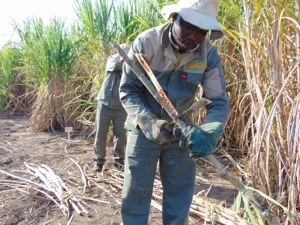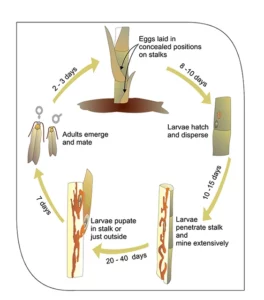 Scouting, by trained farm staff, is done in addition to the official P&D team surveys. Scouting can act as an early warning system, which will alert a grower of the presence of eldana in a particular field or part of the farm.
Scouting, by trained farm staff, is done in addition to the official P&D team surveys. Scouting can act as an early warning system, which will alert a grower of the presence of eldana in a particular field or part of the farm.
The purpose of scouting is to trigger a certain management decision, if required, which will help to control eldana and minimise damage and subsequent financial loss. The management decision could be either prioritising the harvesting of an infested field, or the spraying of an insecticide.
With early detection of problems, more management options will be available. For this reason, the timing of scouting operations is important.
Ideally, scouting should be done as a regular, routine operation throughout the season. As part of an “early detection” system, it makes most sense to scout young cane, which has senescing (dry) leaves at the base of the stalk. This can mean cane from as young as six months of age.
 The first moth peak of the year is generally around March-April-May, so scouting could commence in February.
The first moth peak of the year is generally around March-April-May, so scouting could commence in February.
- The presence of mostly large larvae would indicate that the emergence of moths is imminent, and mating will occur approximately 7 days after pupation.
- Eggs are laid in concealed positions on the stalk, 2 – 3 days after mating.
- 8 – 10 days later the larvae hatch and disperse on the stalk and leaves. Larvae scavenge on the surface of the stalks for up to two weeks.
- It is during this 4-week period that the application of a registered chemical is most effective, targeting moths, eggs or first instar larvae.
Depending on the size of the farm, scouting could continue during March and possibly April. Mature fields could also be included in this round of scouting, to allow for either the rescheduling of harvest dates of certain fields, or the initiation of a spray programme on fields to be harvested later that season (depending on eldana and stalk damage levels).
A second moth peak usually occurs during September-October-November, so scouting should also be done in July-August to prepare for possible spraying, or harvesting of both current and next season’s cane.
The most important times for scouting are Feb-Mar-Apr and then again in July-Aug-Sept. However, as mentioned earlier, scouting should become a regular, routine operation on a cane farm, just as it is with other crops such as macadamias, citrus etc. Due to climate variability from one season to another, moth peaks can start earlier, or last longer than usual, suggesting that the scouting of fields should be done throughout the season and not just limited to the periods mentioned above.

Another form of scouting is the scouting for “Frass volcanoes” in recently harvested fields. This would typically be done in fields which had relatively high eldana numbers (e.g. >10e/100) before harvesting. This type of scouting would be used if a grower plans to use a drench type treatment to control eldana larvae which have gone down into the stools. If left untreated, these larvae will pupate and the subsequent moth emergence will go into adjacent fields, with suitable conditions, to lay eggs.
Following scouting, it is also important to record the scouting results. The maintenance of a scouting record keeping system enables growers to build up a history of borer activity/incidences on the farm, as well as actual spray dates when necessary. This will also inform the local P&D structure, who can in turn, schedule for the re-inspection of sprayed fields, 30 days after spraying.

